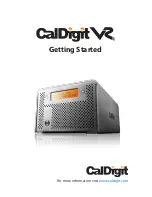
About TimeFinder
EMC TimeFinder delivers point-in-time copies of volumes that can be used for
backups, decision support, data warehouse refreshes, or any other process that
requires parallel access to production data.
Previous VMAX families offered multiple TimeFinder products, each with their own
characteristics and use cases. These traditional products required a target volume to
retain snapshot or clone data.
Starting with HYPERMAX OS, TimeFinder introduced TimeFinder SnapVX which
provides the best aspects of the traditional TimeFinder offerings, combined with
increased scalability and ease-of-use.
TimeFinder SnapVX dramatically decreases the impact of snapshots and clones:
l
For snapshots, this is done by using redirect on write technology (ROW).
l
For clones, this is done by storing changed tracks (deltas) directly in the Storage
Resource Pool of the source device - sharing tracks between snapshot versions
and also with the source device, where possible.
There is no need to specify a target device and source/target pairs. SnapVX supports
up to 256 snapshots per volume. Users can assign names to individual snapshots and
assign an automatic expiration date to each one.
With SnapVX, a snaphot can be accessed by
linking it to a host accessible volume
(known as a target volume). Target volumes are standard VMAX3 TDEVs. Up to 1024
target volumes can be linked to the snapshots of the source volumes. The 1024 links
can all be to the same snapshot of the source volume, or they can be multiple target
volumes linked to multiple snapshots from the same source volume.
Note
A target volume may be linked only to one snapshot at a time.
Snapshots can be cascaded from linked targets, and targets can be linked to
snapshots of linked targets. There is no limit to the number of levels of cascading, and
the cascade can be broken.
SnapVX links to targets in the following modes:
l
Nocopy Mode (Default): SnapVX does not copy data to the linked target volume
but still makes the point-in-time image accessible through pointers to the
snapshot. The point-in-time image will not be available after the target is unlinked
because some target data may no longer be associated with the point-in-time
image.
l
Copy Mode: SnapVX copies all relevant tracks from the snapshot's point-in-time
image to the linked target volume to create a complete copy of the point-in-time
image that will remain available after the target is unlinked.
If an application needs to find a particular point-in-time copy among a large set of
snapshots, SnapVX enables you to link and relink until the correct snapshot is located.
Interoperability with legacy TimeFinder products
TimeFinder SnapVX and HYPERMAX OS provide backward compatibility to legacy
replication products by emulating legacy TimeFinder and IBM FlashCopy replication
products. You can run your legacy replication scripts/jobs on VMAX3 arrays running
TimeFinder SnapVX and HYPERMAX OS without altering them.
Native local replication with TimeFinder
92
Product Guide
VMAX 100K, VMAX 200K, VMAX 400K with HYPERMAX OS
Summary of Contents for VMAX 100K
Page 1: ...EMC VMAX3 Family Product Guide VMAX 100K VMAX 200K VMAX 400K with HYPERMAX OS REVISION 6 5 ...
Page 20: ...Preface 20 Product Guide VMAX 100K VMAX 200K VMAX 400K with HYPERMAX OS ...
Page 46: ...VMAX3 with HYPERMAX OS 46 Product Guide VMAX 100K VMAX 200K VMAX 400K with HYPERMAX OS ...
Page 72: ...Open systems features 72 Product Guide VMAX 100K VMAX 200K VMAX 400K with HYPERMAX OS ...
Page 82: ...Provisioning 82 Product Guide VMAX 100K VMAX 200K VMAX 400K with HYPERMAX OS ...
Page 158: ...Remote replication solutions 158 Product Guide VMAX 100K VMAX 200K VMAX 400K with HYPERMAX OS ...
Page 186: ...Mainframe Error Reporting 186 Product Guide VMAX 100K VMAX 200K VMAX 400K with HYPERMAX OS ...
Page 200: ...Licensing 200 Product Guide VMAX 100K VMAX 200K VMAX 400K with HYPERMAX OS ...
















































